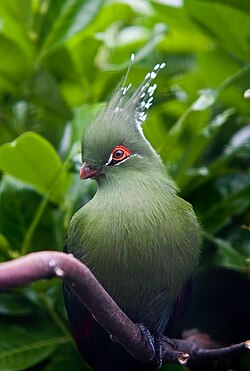| Schalow's turaco | |
|---|---|
 | |
| At Lotherton Bird Gardens, Leeds | |
| Scientific classification | |
| Kingdom: | Animalia |
| Phylum: | Chordata |
| Class: | Aves |
| Order: | Musophagiformes |
| Family: | Musophagidae |
| Genus: | Tauraco |
| Species: | T. schalowi |
| Binomial name | |
| Tauraco schalowi (Reichenow, 1891) | |
 | |
| Distribution of the Schalow's turaco | |

Schalow's turaco (Tauraco schalowi) is a frugivorous bird in the family Musophagidae. This bird's common name and Latin binomial commemorate the German banker and amateur ornithologist Herman Schalow. [2]
